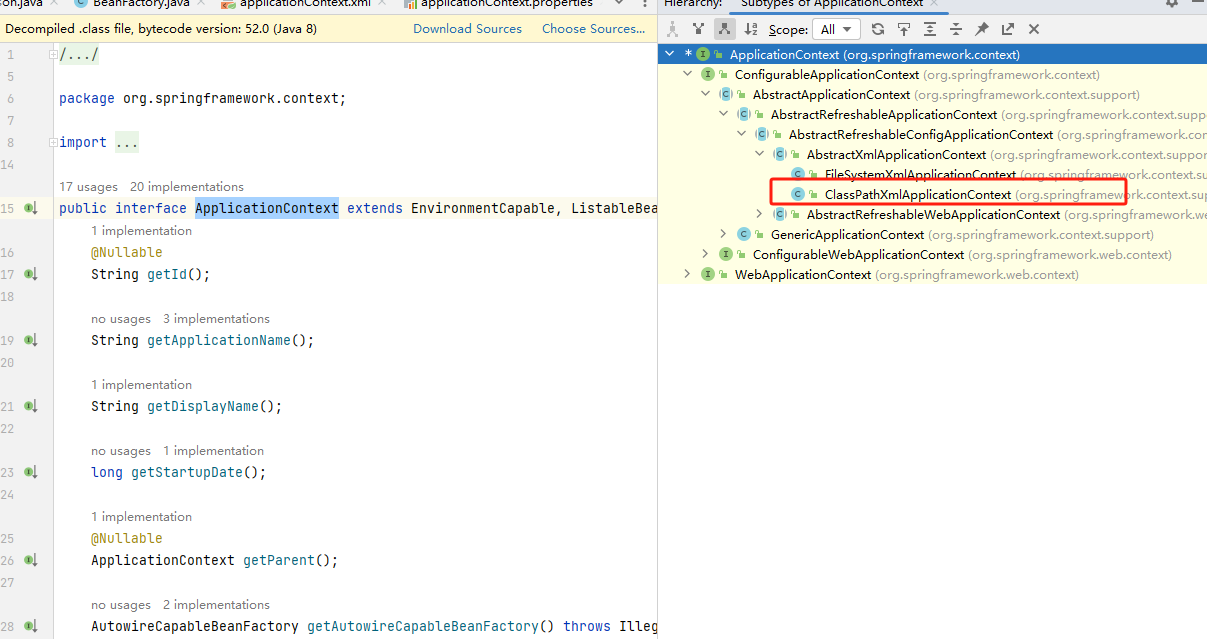Spring5深入浅出篇:第一个Spring程序
发布时间:2024年01月19日
Spring5深入浅出篇:第一个Spring程序
软件版本
1. JDK1.8+
2. Maven3.5+
3. IDEA2018+
4. SpringFramework 5.1.4
官??站 www.spring.io
环境搭建
- Spring依赖
<!-- https://mvnrepository.com/artifact/org.springframework/spring-context -->
<dependency>
<groupId>org.springframework</groupId>
<artifactId>spring-context</artifactId>
<version>5.1.4.RELEASE</version>
</dependency>
- Spring配置文件
主要是有2点:
1.配置文件的存放位置: 任意位置没有硬性要求
2.配置文件的命名: 也没有硬性要求 建议: 最好叫applicationContext.xml
Spring核心API
- ApplicationContext
作用:Spring提供的ApplicationContext这个工厂,用于对象的创建
好处:解耦合,也是Spring的核心工厂类
ApplicationContext接口类型
接口:屏蔽实现的差异,简单的来说就是方便拓展,基于不同环境的多个实现
非web环境(main方法或者junit单元测试中): ClassPathXMLApplication
web环境: XmlWebApplication

重量级资源
ApplicationContext工厂的对着占用大量内存(这里指ApplicationContext的实现类并非接口)
不会频繁的创建对象: 一个应用只会创建一个工厂对象
ApplicationContext工厂: 一定是线程安全的意味着可以被多线程并发访问
第一个Spring程序
程序开发
1. 创建类型
2. 配置?件的配置 applicationContext.xml
<bean id="person" class="com.baizhiedu.basic.Person"/>
3. 通过??类,获得对象
ApplicationContext
|- ClassPathXmlApplicationContext
ApplicationContext ctx = new
ClassPathXmlApplicationContext("/applicationContext.xml");
Person person = (Person)ctx.getBean("person");
可以发现大致流程跟我们之前设计的通用工厂基本一致,都是先创建类型,配置对应的名称和全限定类名,然后通过bean名称创建对象
细节分析
- 名词解释
Spring??创建的对象,叫做bean或者组件(componet)
- Spring工厂相关方法
//通过这种?式获得对象,就不需要强制类型转换
Person person = ctx.getBean("person", Person.class);
System.out.println("person = " + person);
//当前Spring的配置?件中 只能有?个<bean class是Person类型
Person person = ctx.getBean(Person.class);
System.out.println("person = " + person);
如果applicationContext.xml中配置了多个bean class 为Person类型那么Spring会抛出异常
//获取的是 Spring??配置?件中所有bean标签的id值 person person1
String[] beanDefinitionNames = ctx.getBeanDefinitionNames();
for (String beanDefinitionName : beanDefinitionNames) {
System.out.println("beanDefinitionName = " +
beanDefinitionName);
}
//根据类型获得Spring配置?件中对应的id值
String[] beanNamesForType = ctx.getBeanNamesForType(Person.class);
for (String id : beanNamesForType) {
System.out.println("id = " + id);
}
//?于判断是否存在指定id值得bean
if (ctx.containsBeanDefinition("a")) {
System.out.println("true = " + true);
}else{
System.out.println("false = " + false);
}
//?于判断是否存在指定id值得bean
if (ctx.containsBean("person")) {
System.out.println("true = " + true);
}else{
System.out.println("false = " + false);
文章来源:https://blog.csdn.net/weixin_45442617/article/details/135701982
本文来自互联网用户投稿,该文观点仅代表作者本人,不代表本站立场。本站仅提供信息存储空间服务,不拥有所有权,不承担相关法律责任。 如若内容造成侵权/违法违规/事实不符,请联系我的编程经验分享网邮箱:chenni525@qq.com进行投诉反馈,一经查实,立即删除!
本文来自互联网用户投稿,该文观点仅代表作者本人,不代表本站立场。本站仅提供信息存储空间服务,不拥有所有权,不承担相关法律责任。 如若内容造成侵权/违法违规/事实不符,请联系我的编程经验分享网邮箱:chenni525@qq.com进行投诉反馈,一经查实,立即删除!
最新文章
- Python教程
- 深入理解 MySQL 中的 HAVING 关键字和聚合函数
- Qt之QChar编码(1)
- MyBatis入门基础篇
- 用Python脚本实现FFmpeg批量转换
- 突破通胀风险,聚焦现货黄金投资机遇
- Obtect Detection,物体检测10年的发展,物体检测历史最佳网络
- 【Vue2+3入门到实战】(1)Vue基础之Vue简介、Vue实例创建、差值表达式、响应式特性、Vue开发者工具安装 详解
- 理解基于 Hadoop 生态的大数据技术架构
- win11 C盘出现感叹号
- 北京二手房信息数据分析及可视化笔趣看小说斗鱼直播房间直播动态数据采集王者荣耀小助手爬虫数据采集程序源代码
- Codalab平台学习笔记
- 我的2023
- 实战|验证码突破思路
- Alphalens因子分析(4) - Information Coefficient方法